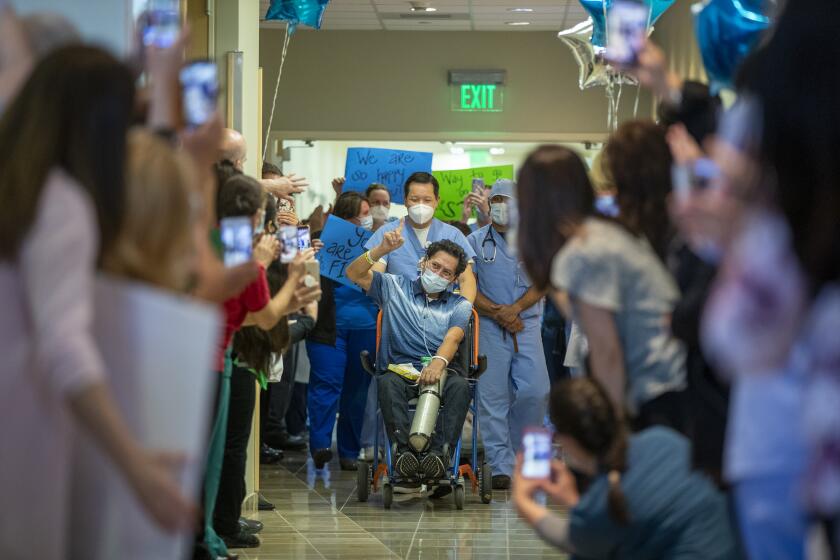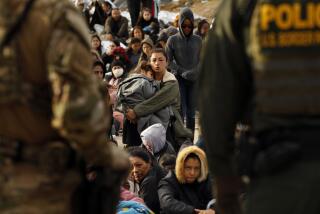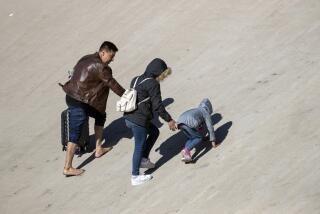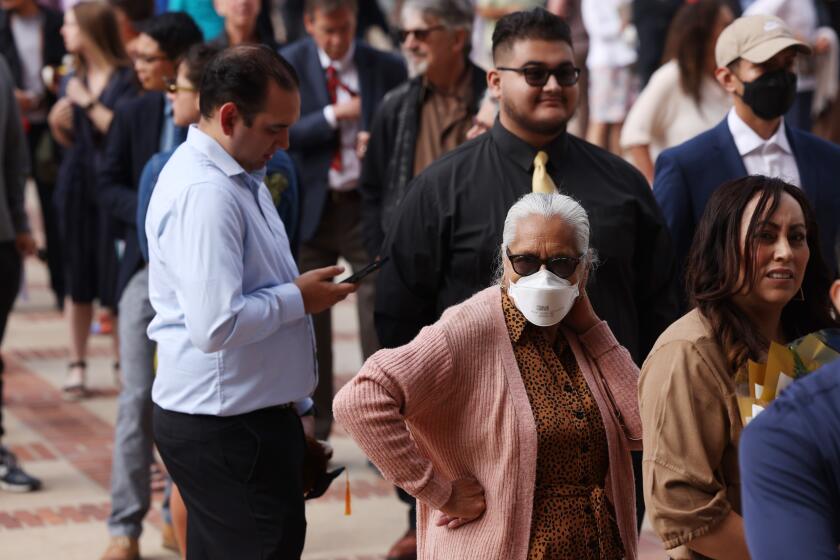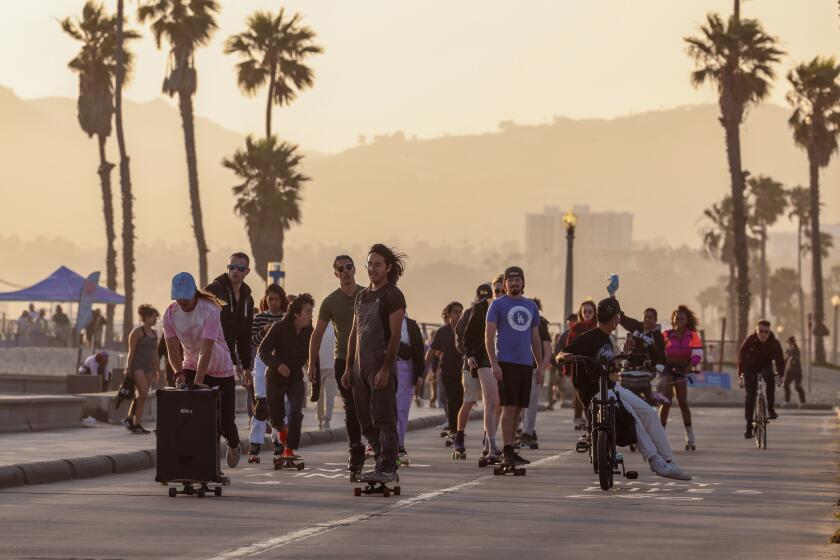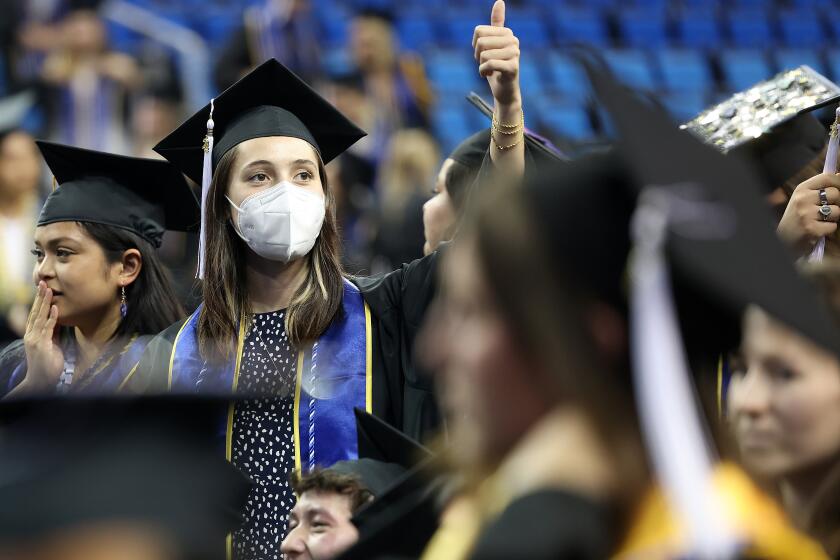Trump says he’ll suspend green card applications amid coronavirus outbreak

President Trump, citing the economic impact of the coronavirus shutdown, on Tuesday ordered a 60-day ban on new immigrants seeking permanent status in the United States.
The ban will cover people seeking green cards that provide permanent status, not temporary visitors. It would also not affect foreign agricultural laborers, Trump said. Although he cited the need to protect American workers, his announcement did not spell out how the order would accomplish that goal.
The administration has already sharply restricted immigration, including steps taken last month to respond to the coronavirus outbreak. White House officials have said additional actions beyond those Trump announced could affect foreign workers currently in industries that are not considered essential, but the president suggested that no such steps are imminent.
These are some of the unusual new scenes across the Southland during the coronavirus outbreak.
The president said he expected to sign the new order Wednesday, although he added that “it’s being written now as we speak,” suggesting that important details could still change.
“We want to protect our U.S. workers,” Trump said in announcing the ban.
“By pausing immigration, we will put Americans first in line for jobs as America reopens,” he added. “A short break from new immigration will protect the solvency of our healthcare system and provide relief to jobless Americans.”
Last fiscal year, the U.S. granted lawful permanent residence, broadly known as a green card, to nearly 577,000 individuals. Officials approved 500,000 more petitions for non-immigrant workers that Trump said Tuesday will not be affected by his order, including agricultural and other temporary workers.
The announcement targeting green cards came after a day of confusing messages. Trump tweeted Monday night that he planned to sign an order to “temporarily suspend immigration into the United States!” White House and Homeland Security Department officials were left to play catch-up, unable to answer questions about what the president intended.
On Tuesday, Trump acknowledged the ban was not the sweeping sealing-off of the United States that his tweet had hinted at, and he added that immigrants already in the United States “are not supposed to be” in more danger of removal under the order.
He also suggested that some immigration for family unification may continue.
“We have to do that obviously even from a humane standpoint — there will be some people coming in,” he said.
Past plans from the White House have favored parents, spouses and children while proposing to bar other relatives, but it was unclear what exemptions the current plan would involve.
The lack of clarity reflected the often-chaotic nature of policymaking in Trump’s White House.
Trump has been openly frustrated with polls showing the majority of Americans think he has done a bad job in handling the coronavirus outbreak, and he has frequently turned to immigration — a main campaign staple for him — when he feels a need to demonstrate executive action.
On Tuesday afternoon, the president’s reelection campaign sent an email to supporters touting the potential action and denouncing “fierce criticism from the Fake News media and their Democrat Partners” even as no details had been announced and no order had been signed.
House Speaker Nancy Pelosi (D-San Francisco), in an interview on PBS, dismissed the president’s move as a “distraction.”
Trump is “always engaged in distractions like immigration, distractions like supporting people in the street,” Pelosi said. “They’re all distractions away from the fact ... that he’s a total failure when it comes to testing.”
Because the president has often promised sweeping executive actions that have not lived up to his rhetoric, without written text it is impossible to judge the full impact of his pledge.
Like other efforts by the administration to bypass certain U.S. laws and international obligations in order to achieve its long-stated goal of dramatically reducing immigration to the United States, Trump’s executive action is likely to face legal challenge.
Although an across-the-board ban has never been imposed in the U.S., immigration law gives the president broad authority to restrict entries in emergencies. The Supreme Court in 2018 upheld Trump’s authority to impose a travel ban on a group of countries, most of which have Muslim majorities, that the administration said posed a terrorism risk.
Yet Stephen Yale-Loehr, professor of immigration law at Cornell Law School in New York, said the president’s latest order targeting potential permanent residents probably exceeds Trump’s legal authority.
Even before Trump’s announcement, officials had put most entries into the U.S. on hold. Just Monday, the administration extended what is in effect the closure of U.S. borders with Canada and Mexico to “nonessential travel,” as well as a controversial order from the Centers for Disease Control and Prevention that immigration officials are citing to rapidly expel most migrants at the U.S. southern border.
In a month, border authorities have turned back roughly 11,000 migrants with minimal processing, including, for the first time under the U.S. modern immigration system, asylum seekers and hundreds of unaccompanied children.
Beyond the border, most visa offices abroad have closed, applications for other travel to the U.S. have been frozen, and interviews for citizenship and other forms of permanent legal status have been suspended. Immigration courts across the country have been shuttered, and hearings suspended or rescheduled.
The refugee program, already drastically reduced, has practically ground to a halt.
The administration has made exceptions for some workers amid the pandemic, however. Officials recently touted bringing in Mexican and Central American agricultural laborers and extending H-2A permissions for seasonal workers, saying that would “protect the nation’s food supply chain, and lessen impacts from the coronavirus [COVID-19] public health emergency.”
On Tuesday, Trump said that with the new ban, “farmers will not be affected.... If anything, we’re going to make it easier.”
Although Trump said he doesn’t want out-of-work Americans to face immigrant “competition” for jobs, Theresa Cardinal Brown, a former Homeland Security Department official at the Bipartisan Policy Center, said research shows immigrants don’t compete with native-born workers for employment, or lower their wages.
“Immigrants are highly represented in the very jobs that are sustaining our economy now,” Cardinal Brown said in a statement responding to Trump’s announcement, “especially frontline healthcare workers, as well as grocery clerks, food and agriculture production, and delivery services.”
Yale-Loehr said continuing to permit temporary visitors while barring green card applicants undermines the administration’s argument that the measure is a necessary part of its pandemic response.
“If the purpose of the executive order is to help prevent the spread of coronavirus,” he said, “it defies logic to bar green card applicants but still admit people applying for temporary visas.”
Trump’s move came amid a difficult political stretch for the president. A Washington Post poll released Tuesday morning said 54% of Americans view his response to the pandemic negatively, while 72% say governors have done a good job in handling the coronavirus crisis. New York Gov. Andrew Cuomo, a Democrat whose televised briefings have made him one of the most prominent faces among governors, met with the president at the White House on Tuesday.
Trump often returns to the topic of immigration when he is concerned about losing support from his political base.
On Monday, he invited an Army lieutenant general to discuss the construction of temporary hospitals, only to ask him for an update on building the wall along the border with Mexico, Trump’s signature campaign promise. On Tuesday, Trump brought up the wall again.
Get our L.A. Times Politics newsletter
The latest news, analysis and insights from our politics team.
You may occasionally receive promotional content from the Los Angeles Times.
Inside and outside the White House, some Trump aides and allies have pushed him to focus on meeting the “commander in chief” moment the pandemic has presented.
But he remains concerned about maintaining his political base, which two people who have spoken with him in recent days view as the reason why he has encouraged his supporters in certain states to “liberate” themselves from stay-at-home orders issued by several Democratic governors — and why he is pushing forward with the anti-immigration approach that propelled his campaign four years ago.
Times staff writer Chris Megerian in Washington contributed to this report.
More to Read
Get the L.A. Times Politics newsletter
Deeply reported insights into legislation, politics and policy from Sacramento, Washington and beyond. In your inbox three times per week.
You may occasionally receive promotional content from the Los Angeles Times.
